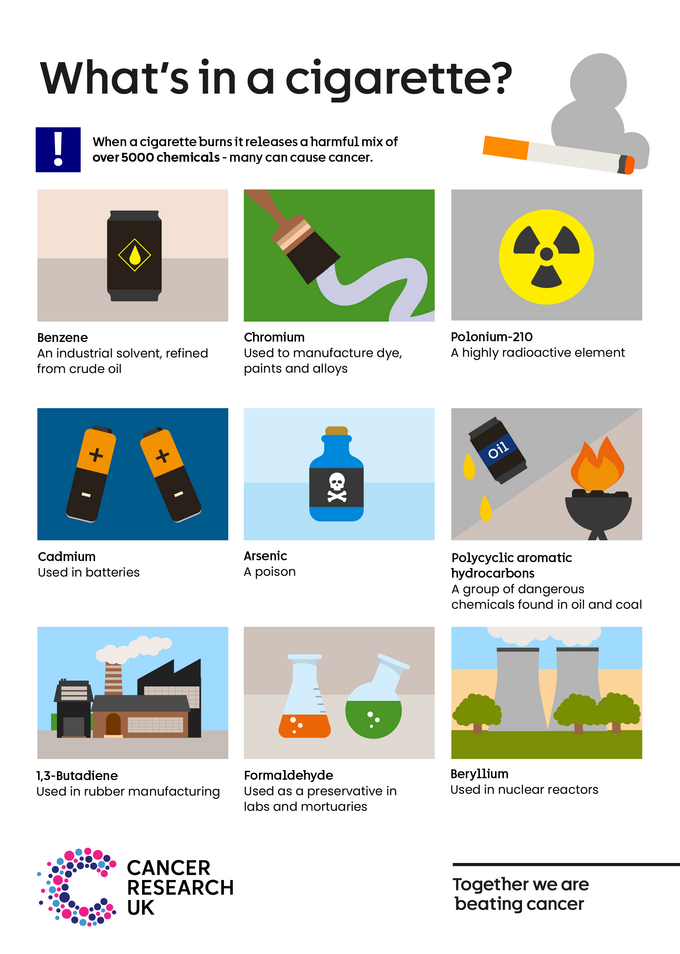What’s in a cigarette?
- Cigarettes release over 5,000 different chemicals when they burn and many of these chemicals are poisonous.
- At least 70 chemicals in tobacco smoke cause cancer.
- There is no safe level of smoking - stopping completely is the best thing you can do for your health.
Cigarettes contain many dangerous chemicals. Some occur naturally in tobacco, and others are formed when processing tobacco into cigarettes. When a cigarette is burnt, it releases thousands more chemicals in tobacco smoke. Many of these chemicals are harmful to people who smoke and also to people who breathe in second-hand smoke. We know that at least 70 of these chemicals cause cancer.
Roll-up tobacco cigarettes are not safer. They contain the same cancer-causing chemicals as manufactured cigarettes. Smoking using a filter, and smoking ‘low-tar’ or ‘light’ cigarettes also doesn’t reduce the risk of disease from smoking. These are not safer or healthier options, and in the UK it is against the law to call tobacco products ‘light’, ‘mild’ or ‘low-tar’.
Cigarettes are the most common type of tobacco used in the UK. But tobacco comes in many different forms. These include cigars, pipes, shisha and smokeless tobacco, such as paan or snus. All forms of tobacco are addictive and cause cancer, so there is no safe way to use tobacco.
Find out about the harms of other forms of tobacco.
What’s in tobacco smoke?
Tar
Tar is a sticky-brown substance that collects in the lungs when tobacco smoke is breathed in. It can stain fingers and teeth a yellow-brown colour.
Tar contains cancer-causing chemicals. It also increases the risk of lung diseases, such as emphysema and chronic obstructive pulmonary disease (COPD).
Carbon Monoxide
Tobacco smoke contains a poisonous gas called carbon monoxide. You can’t smell it, see it or taste it.
Carbon monoxide stops the blood from carrying as much oxygen. This means organs of the body don’t get the amount of oxygen they need, and the heart must work harder to supply the body with oxygen. This increases the risk of heart disease and stroke.
Nicotine
Nicotine is a very addictive chemical. Most people who smoke don't continue to do so out of choice – it’s because they have a nicotine addiction.
Nicotine does not cause cancer. People have used nicotine replacement therapy (NRT) safely for many years to help them stop smoking. NRT helps people deal with cravings and nicotine withdrawal symptoms.
Find out more about NRT on our how do I stop smoking page.
Over 5,000 different chemicals
Tobacco smoke is made up of thousands of chemicals. These include toxic metals, poisonous gases and chemicals that are known to cause cancer.
The chemicals in tobacco smoke mix when they are inhaled together and cause greater damage to the body. Some chemicals help other cancer-causing chemicals to damage the cells of the body.
What ingredients in cigarettes cause cancer?
At least 70 of the chemicals found in tobacco smoke cause cancer.
You may be surprised to learn where some of the cancer-causing chemicals in cigarettes are also used:
- 1,3-Butadiene is used in rubber manufacturing
- Arsenic is a poison
- Benzene is an industrial solvent, made from crude oil
- Beryllium is used in nuclear reactors
- Cadmium is used in batteries
- Chromium is used to manufacture dye, paint and car alloys
- Formaldehyde is used in science labs and mortuaries
- Polonium-21 is a highly radioactive element
- Polycyclic aromatic hydrocarbons are a group of dangerous chemicals found in oil and coal, including benzo(a)pyrene
How do chemicals in tobacco smoke lead to cancer?
Here are some of the ways that harmful chemicals in tobacco smoke damage the body:
Chemicals in tobacco smoke damage DNA.
Our DNA controls how our cells grow and behave. DNA damage can cause cells to behave in ways they’re not supposed to, which can lead to cancer.
Chemicals in tobacco smoke damage DNA. This includes the parts of DNA that protect our cells from becoming cancerous. There are also chemicals in tobacco smoke that stop our cells from repairing damaged DNA. This makes it even more likely that cancer will develop.
Chemicals in tobacco smoke harm the cleaning system in our airways.
Chemicals in tobacco smoke damage the cilia in our airways. Cilia keep our airways clear from dirt and infections.
This means people who smoke are less able to clear toxic chemicals. The chemicals build up and cause damage. A cough is often developed as the lungs try to clear themselves.
Chemicals in tobacco smoke may affect our immune system and cause inflammation.
Our immune system is designed to protect us. But some research suggests chemicals in tobacco smoke may affect how our immune system works. Chemicals in tobacco smoke have also been shown to cause inflammation, which can lead to DNA damage.
Find out more about how smoking causes cancer.
It’s never too late to stop smoking
If you smoke, the best thing you can do for your health is to stop completely.
We know that stopping smoking can be hard, but you don’t have to do it alone. There are a range of tools and support services to help you succeed.
Action on Smoking and Health. What’s in a cigarette (2022). https://ash.org.uk/resources/view/whats-in-a-cigarette
International Agency for Reseach on Cancer. Personal Habit and Indoor Com bustion: Tobacco Smoking. Vol 100 E, 377–504 (2012). https://www.ncbi.nlm.nih.gov/books/NBK304395/
US Surgeon General. How Tobacco Smoke Causes Disease: The Biology and Behavioral Basis for Smoking-Attributable Disease. (2010).
Last reviewed: 7 June 2023
Next review due: 7 June 2026



